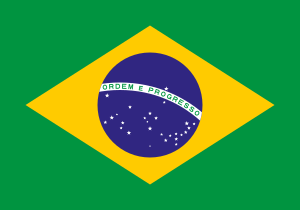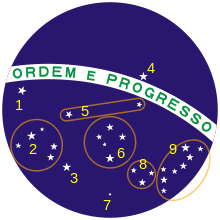Brazil's flag
The flag of Brazil is made up of a green rectangle with a 7:10 ratio. Above this rectangle, a yellow rhombus appears, and within it, a blue circle with a white band that contains the motto "ORDEM E PROGRESSO" ("Order and Progress" in Portuguese) in green, as well as 27 white stars.
Proa flag
Presidential Standard
Historical flags
Flags of the Royal Houses of Portugal
During the colonial domination of Brazil by Portugal, various flags based on the emblems of the Lusitanian monarchy were used. The first flags used by navigators and explorers included the Cross of the Order of Christ next to the Royal Shield.
Flags of colonial Brazil
In 1645 the first properly Brazilian flag was created, when the Principality of Brazil was founded, a title reserved for the first-born male heirs of the Portuguese Crown, until 1743, the year in which the princesses successors to the throne were also included.
The princes of Brazil were represented in America by a Governor-General until 1714, to be definitively supplanted by viceroys of Brazil, forming from that year the Principality-Viceroyalty of Brazil until 1808.
The Brazilian flag then consisted of a golden armillary sphere on a white field, being used until the nominal founding of the Kingdom of Brazil, from the last year mentioned above until 1815, whose flag would become made up of the armillary sphere centered on a blue field, due to the transfer of the Portuguese Court to Rio de Janeiro after fleeing from the Napoleonic forces, and which would become part of the United Kingdom of Portugal, Brazil and the Algarve, after the formal recognition of the European powers in 1816.
Flag of the Kingdom of Brazil (1808 - 1815, not yet internationally recognized).
Independence
On September 7, 1822, the Kingdom of Brazil declared itself independent from Portugal and assumed the official title of Empire of Brazil, which it held until November 15, 1889. The base of the current national flag consisted of a field green that represented the Braganza house of Emperor Pedro I, with a yellow rhombus that identified the Habsburgs, family of the Empress María Leopoldina. Above this was the Imperial Shield.
Republic
The current flag is based on the old flag of the Empire of Brazil created by Jean-Baptiste Debret in 1820. The changes were devised by a group of members of the Positivist Church, composed of Raimundo Teixeira Mendes, Miguel Lemos and Manuel Pereira Reis. The design of the blue disk was executed by the painter Décio Vilares. The flag was officially adopted by Decree 4, on November 19, 1889 drafted by Benjamin Constant Botelho de Magalhães, member of the Provisional Government. That day it was raised for the first time in a square in the Rio neighborhood of Praça da Bandeira.
From the proclamation of the Republic on November 15 to the 19th of the same month, another flag was used that imitated that of the United States of America. The current flags of some of the states of Brazil, such as Goiás, Piauí or Sergipe, are inspired by this design.
The current design, which includes a total of 27 stars, was officially approved through Decree No. 8,241 promulgated on May 12, 1992.
Symbolism

 Second flag of the Federal Republic of Brazil (11 May 1992 to present).
Second flag of the Federal Republic of Brazil (11 May 1992 to present).The current flag of Brazil originates from the flag of the Empire of Brazil designed in 1822, whose symbols represented the royal families of Braganza and Habsburg, to which the first imperial house belonged.
The blue disk of the current flag represents the sky of Rio de Janeiro on the morning of November 15, 1889 (date of the proclamation of the Republic of Brazil). Shown as seen from outside the celestial sphere. Each of the twenty-seven stars represents one of the different states and the Federal District. The number of stars has varied throughout history as new states were created, from the original twenty-one.
The star that represents the Federal District is Sigma Octantis, whose position makes it visible throughout the country throughout the year; Furthermore, due to its location, the rest of the stars represented on the flag appear to rotate around it. The star of the state of Pará appears above the others because at the time of independence it was the province with the capital, Belém, northernmost of all, near the line of the terrestrial equator (the states of Roraima and Amapá, which Currently they are further north, they were created during the Republican period).
The lone star at the top of the sphere is Spike (Alpha of Virgo) and has a double meaning on the flag: the first is to show that Brazil occupies territories in the two hemispheres (northern and southern); the second, make a reference to agriculture, since the Greek goddess Demeter (Ceres for the Romans) was represented carrying a cereal in her hand (Spica, in Latin). Spike was also related to the discovery of the precession of the equinoxes by the great ancient astronomer Hipparchus of Nicaea (190-120 BC), one of the greatest discoveries of astronomy in antiquity.
The Cross (Southern Cross) is a memory of the first name of Brazil given by the Portuguese: Land of the Holy Cross. It occupies the center of the sphere, because on the day of the proclamation of the republic, this constellation passed over the meridian of the city of Rio de Janeiro (the meridian of the place or meridian line is the imaginary line that passes through both poles and the zenith and separates the eastern from the western hemisphere).
Below the South Cross, to the left, you can see the star Canopus of the Carinae constellation. Canopus recalls the legend of the Argonauts, and was placed to symbolize the voyages of the Portuguese explorers during the period of the great navigations.
The motto "Ordem e Progresso" ("order and progress") is inspired by Auguste Comte's motto of positivism: «L'amour pour principe et l'ordre pour base; le progrès pour but» (‘Love as a principle, order as a basis, progress as a goal’, in French).
The stars

The celestial sphere of the flag does not appear as seen from Earth, but as if it were seen from outside. The Spike star is actually located a little further south of the Earth's equator, but on the flag it appears to the north, marking, as mentioned, the fact that Brazil is located in both hemispheres. Curiously, the star Procyon, which is actually located in the northern hemisphere, appears in the southern hemisphere on the flag. In the representation, the pointers of the Southern Cross, Alpha and Beta of Centauri, which are the two brightest stars in the area, have been left aside, but the constellations of the Southern triangle, part of Hydra and Scorpio, do appear, although this last not entirely well represented in its form.
The constellations and stars represented on the flag are:
- Procyon (α Canis Minoris),
- Canis Maior, whose biggest star is Sirius,
- Canopus (α Carinae),
- Espiga (α Virginis)
- Hydra
- Crux
- Sigma Octantis (σ Octantis; Star of the South Pole)
- Triangulum Australe
- Scorpius, whose biggest star is Antares
The stars that represent the states of Brazil and the Federal District are:
| State | Star | Constellation | Size |
|---|---|---|---|
| Amazon | Alpha Canis Minoris (Procyon) | Canis Minor | 1 |
| Mato Grosso | Alpha Canis Majoris (Sirius) | Canis Major (Can Mayor) | 1 |
| Amapa | Beta Canis Majoris (Mirzam) | Canis Major (Can Mayor) | 3 |
| Rondônia | Gamma Canis Majoris (Muliphen) | Canis Major (Can Mayor) | |
| Roraima | Delta Canis Majoris (Wezen) | Canis Major (Can Mayor) | 2 |
| Tocantins | Epsilon Canis Majoris (Adhara) | Canis Major (Can Mayor) | 2 |
| Stop. | Alpha Virginis (Spiga) | Virgo | 1 |
| Piauí | Alpha Scorpii (Antares) | Scorpius (Scorpio) | 1 |
| Maranhão | Beta Scorpii (Graffias) | Scorpius (Scorpio) | 3 |
| Ceará | Epsilon Scorpii | Scorpius (Scorpio) | 2 |
| Alagoas | Theta Scorpii (Sargas) | Scorpius (Scorpio) | 2 |
| Sergipe | Iota Scorpii | Scorpius (Scorpio) | 3 |
| Paraíba | Kappa Scorpii | Scorpius (Scorpio) | 3 |
| Rio Grande del Norte | Lambda Scorpii (Shaula) | Scorpius (Scorpio) | 2 |
| Pernambuco | Mu Scorpii | Scorpius (Scorpio) | 3 |
| Mato Grosso del Sur | Alpha Hydrae (Alphard) | Hydra (Hidra Macho) | 2 |
| Acre | Gamma Hydrae | Hydra (Hidra Macho) | 3 |
| São Paulo | Alpha Crucis (Acrux) | Crux (Southern Cross) | 1 |
| Rio de Janeiro | Beta Crucis (Becrux) | Crux (Southern Cross) | 2 |
| Bahia | Gamma Crucis (Gacrux) | Crux (Southern Cross) | 2 |
| Minas Gerais | Delta Crucis | Crux (Southern Cross) | 3 |
| Holy Spirit | Epsilon Crucis | Crux (Southern Cross) | 4 |
| Rio Grande del Sur | Alpha Trianguli Australe | Triangulum Australe (Triangle) | 2 |
| Santa Catarina | Beta Trianguli Australe | Triangulum Australe (Triangle) | 3 |
| Paraná | Gamma Trianguli Australe | Triangulum Australe (Triangle) | 3 |
| Goiás | Alpha Carinae (Canopus) | Carina (Quilla) | |
| Federal District | Sigma Octantis | Octans | 5 |
State flags
This gallery of flags of the States of Brazil shows the flags of the 26 states of Brazil and the Federal District.
Flag of Acre
Flag of Alagoas
Flag of Amapá
Flag of Amazonas
Bay flag
Flag of Ceará
Flag of the Holy Spirit
Flag of Goiás
Flag of Maranhão
Flag of Mato Grosso
Flag of Mato Grosso del Sur
Flag of Minas Gerais
Flag of Para
Flag of Paraíba
Flag of Paraná
Flag of Pernambuco
Flag of Piauí
Flag of Rio de Janeiro
Flag of Rio Grande del Norte
Flag of Rio Grande del Sur
Flag of Rondonia
Flag of Roraima
Flag of Santa Catarina
Flag of São Paulo
Flag of Sergipe
Flag of Tocantins
Flag of the Federal District
Other flags
United States Presidential Standard (1907-1947)
United States Presidential Standard (1947-1968)
Presidential Standard of the Federal Republic of Brazil (1968-1971)
Presidential Standard of the Federal Republic of Brazil (1971-1992)
Presidential Standard of the Federal Republic of Brazil (1992-Presente)
Contenido relacionado
483
472
471



















































